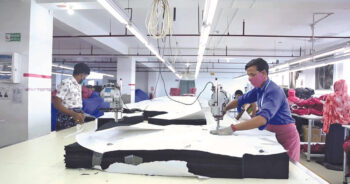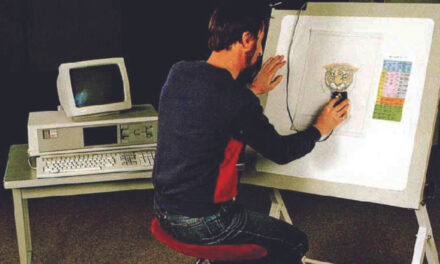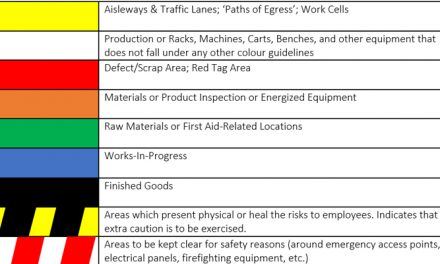 The cutting department is responsible for cutting fabrics and feeding the sewing department with cuttings. The cutting department’s capacity is planned based on the daily feeding requirement of the sewing lines. The cutting department is set up with a cutting department head, cutters, spreaders, quality checkers and helpers for sorting, ply numbering and bundling. The activities of the cutting department are explained in this post.
The cutting department is responsible for cutting fabrics and feeding the sewing department with cuttings. The cutting department’s capacity is planned based on the daily feeding requirement of the sewing lines. The cutting department is set up with a cutting department head, cutters, spreaders, quality checkers and helpers for sorting, ply numbering and bundling. The activities of the cutting department are explained in this post.
Take fabric from the fabric store
The cutting department gets a cut order from the production manager. According to the cutting plan, the cutting in-charge generates a fabric requirement sheet or requisition slip to the fabric store to issue fabrics.
Relaxation of fabrics
Knitted fabrics require relaxation before cutting. After receiving the fabric from the fabric store, the cutting department opens the fabric from the fabric roll and lays it on the table for relaxation for some hours before cutting. Factories also relax fabric in the fabric store overnight after opening the fabric rolls.
Cut order planning
The cutting master plans the number of markers they need to prepare, the size combination to be set for each marker and the number of plies to be laid in each marker.
Fabric spreading/layering
In mass production, multiple layers of fabric are cut at the same time. So spreaders lay the fabric on a cutting table as per total marker length. The layer height is kept up to a certain inch.
Planning markers
The cutting master plans marker ways, marker lengths and the numbers of plies to be laid in each lay.
Making markers
This is a process of making an outline of garment patterns on the lay for cutting garment components. After layering, the marker paper is laid on the top of the layer. Those factories that don’t have CAD markers make markers manually using paper patterns.
Cutting fabrics
After making the marker, garment patterns are cut and taken out from the layer. Various technologies are used for cutting fabric layers, such as straight knife cutting, band knife machine cutting and a computer-controlled automatic cutting machine.
Sorting, bundling and numbering of garment plies
After cutting the fabric, layers are sorted size-wise and color-wise. Each ply is numbered using stickers. Bundles are kept on inventory tables, before these are sent to undergo the next process.
Inspecting cut components
To maintain the cutting quality, standard cutting components are checked randomly by quality checkers. If defective components are found, they replace those defective parts.
Sorting printed and embroidery panels
 As per order requirements, printing and embroidery is done on cut panels. Size-wise sorting is done after receiving printed and embroidered panels. The checking of printed and embroidered panels is also done by the cutting department.
As per order requirements, printing and embroidery is done on cut panels. Size-wise sorting is done after receiving printed and embroidered panels. The checking of printed and embroidered panels is also done by the cutting department.
Re-cutting panels
Re-cutting is done for garment components that require to be replaced in bundles. Re- cutting requests are received from the sewing department for defective garment parts. Re-cutting is also done for block panels cut for the printing and embroidery processes. After receiving garment panels from the printer or embroiderer, these panels are reshaped.
Fusing garment components
Fusing in garment components is done to stiffen parts of a garment. If needed, fusing is done at the cutting section (e.g. fusing of the collar and cuff components of formal shirts).
Cutting Mistakes in garment factories
There is lot of human intervention in cutting room activities. As a result, so many mistakes are happening in cutting activities. How to deal with such mistakes in cutting department? The common problems that we face due to mistakes of workers in cutting are:
• Delay in cutting process
• Excess manpower requirement
• Excess power consumption
• Wastage of fabrics and other materials
• Increased cutting backlogs
In a single sentence, mistakes in cutting department increases production cost per piece and the recovering process is always frustrating.
Here cutting means cutting of garment components from fabric sheet. To find the solution of cutting issues, you need to understand the pattern of mistakes. So we will first look into common mistakes and then would find possible solutions. To know the pattern of mistakes, ask yourself the following questions
1. Is mistake happening due to carelessness of the workers? Or
2. Is it due to short coming of process design? Or
3. Is it happening due to an unforeseen cause? Or
4. Is your cutting team incapable of doing certain things due to lack of training and knowledge?
Common cutting mistakes are
1. Wrong patterns: Pattern modification is not done based on fabric shrinkage report or FIT comments is not incorporated in production patterns. This kind of mistake majorly happens where there is no standard procedure of pattern marking and pattern handover to cutting department. This kind of mistakes can also happen due to carelessness cutting workers or having little knowledge about patterns and its effects in production.
2. Cutting a wrong size ratio: it might be a result of carelessness of the workers.
3. Fabric received without prior quality check and approval based on test report: Further this is a result of not following standard procedure of fabric issue to cutting department. Not making shade band for fabrics with shade variation.
4. Missing notch mark: Notch mark is not given at desired position of the pattern or there is notch mark in the pattern, but cutter miss to cut notches in fabric lay. This may be a result of carelessness of employees.
5. Numbering mistakes: Workers are not trained for the work or they are carelessness.
6. Following wrong cutting plan: Cutting plan sometimes doesn’t match with the requirement of sewing department when cutting department doesn’t work according to daily cutting plan. Or change of production plan might not be communicated to cutting in- charge.
The above points are some common mistakes of cutting department, but mistakes are not limited to these only. You might face other kind of mistakes. You can send
us mail about the mistakes occur in your cutting department or write the same in the following comment box.
How to deal with cutting problems?
The smart answer of this question is
• Study the frequency of mistake occurrences
• Pick top 3 major mistakes first
• Find root causes of the mistakes
• Work on removing the root cause from the process
• Reduced mistakes in the subsequent orders
• Continue reading for the possible solutions
I know this smart answer would not work for you. You need step by step guides. Right?
Possible solutions
Following are the possible solution of above mistakes
Dealing with pattern related mistakes
Keep a check point for checking garment patterns before issuing pattern to cutting department. You can develop couple of samples prior to bulk cutting based on production pattern. I mean, cut fabric with patterns sew garments finish garments and check the quality.
If you found variation in finished garments, then correct it prior to bulk cutting.
If you religiously make pre-production (PP) samples and check the samples according to buyer specifications, you would not get surprise things like – measurement issues and fit problems in bulk production.
Sometimes, problem doesn’t lie with patterns but cutting department use wrong pattern/old pattern. Set a standard procedure that pattern master needs to seal each final pattern and approve the same. Style number (article number) and component name should be written on pattern. Cutting depart should not be allowed to use any other pattern than approved one for a style and season. Other precaution should be taken related to patterns are
• Numbering of pattern pieces should be done (like pattern piece number 02 of 16 or number 03 of 16).
• Clearly mention on patterns whether fabric to be cut in folded form or in open width.
• How many components to be cut for single pieces from a single pattern piece. Like for shirt cuff patterns, four component needs to be cut where cutting department get one pattern piece for cuff.
Dealing with complete cutting process
Pilot production run is the solution. You might do Pilot Run prior to bulk cutting. If you do this process then all problems exist in cutting process, whether it is fabric issue or pattern issue would come out in the pilot run pieces. You might loss some fabric in this process but not the whole fabric.
Cutting defects or mistakes
All cutting defects can be taken care of by setting quality check point for layers and cut components. Also check shorting and bundling activities. Like size mixing and ply mixing possibilities.
Following Cut Plan
Companies follow different procedures for cut planning. In most companies, cutting department gets weekly cutting schedules and if there are changes on existing plan, cutting department gets updated plan. Still there may be some communication gap between cutting department and production department. This kind of issues can be controlled by having daily morning meeting between core production departments in a factory.
Conclusion
Solution can be simplified by following standard procedure of cutting activities. If you have not yet developed standard operating procedure (SOP) for cutting room activities, develop it and ensure that everyone in cutting department follow the standard working procedures. To make it further error proof, set standard procedure for fabric department and sampling and pattern making department also.













